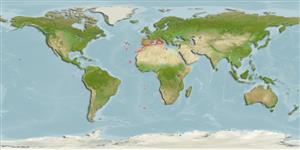>
Carangiformes (Jacks) >
Carangidae (Jacks and pompanos) > Caranginae
Etymology: Trachurus: Greek, trachys, -eia, -ys = rough + Greek, oura = tail (Ref. 45335).
Environment: milieu / climate zone / depth range / distribution range
Ökologie
seewasser benthopelagisch; ozeanodrom (Ref. 51243); tiefenbereich 305 - 370 m (Ref. 56504). Subtropical; 45°N - 41°S, 32°W - 17°E
Eastern Atlantic: southern Bay of Biscay to southern Morocco including Azores, Madeira , Canary Islands, Tristan de Cunha and Gough Islands. Also known from the western part of the Mediterranean Sea. Reported from Mauritania (Ref. 55783). Is also reported from the eastern part of Mediterranean by several references that may need confirmation - see the list of countries (NB).
Length at first maturity / Size / Gewicht / Alter
Maturity: Lm 24.7, range 24 - 49.5 cm
Max length : 60.0 cm TL Männchen/unbestimmt; (Ref. 7097); common length : 25.0 cm FL Männchen/unbestimmt; (Ref. 3397); max. veröff. Alter: 18 Jahre (Ref. 109005)
Adults are found at depths ranging from 305 to 368 m in the eastern Ionian Sea (Ref. 56504). They can be seen up to depth of 370 m (Ref. 4233). They are confined to neritic zones of island shelves, banks and sea mounts; a schooling species (Ref. 4233). Known to migrate between the coast of Sahara and the offshore seamounts possibly reaching the Cape Verde Islands (Ref. 26139). They feed mainly on crustaceans (Ref. 4233). Eggs are pelagic (Ref. 4233).
Smith-Vaniz, W.F., 1986. Carangidae. p. 815-844. In P.J.P. Whitehead, M.-L. Bauchot, J.-C. Hureau, J. Nielsen and E. Tortonese (eds.) Fishes of the north-eastern Atlantic and the Mediterranean. UNESCO, Paris. vol. 2. (Ref. 4233)
IUCN Rote Liste Status (Ref. 130435)
Bedrohung für Menschen
Harmless
Nutzung durch Menschen
Fischereien: kommerziell
Mehr Information
ReferenzenAquakulturAquakultur ProfilZuchtlinienGenetikElectrophoresesVererbbarkeitKrankheitenVerarbeitungNutrientsMass conversion
Tools
Zusatzinformationen
Download XML
Internet Quellen
Estimates based on models
Preferred temperature (Ref.
123201): 9.6 - 14.1, mean 13.1 °C (based on 5 cells).
Phylogenetic diversity index (Ref.
82804): PD
50 = 0.5001 [Uniqueness, from 0.5 = low to 2.0 = high].
Bayesian length-weight: a=0.00933 (0.00798 - 0.01091), b=2.96 (2.93 - 2.99), in cm total length, based on LWR estimates for this species (Ref.
93245).
Trophic level (Ref.
69278): 3.3 ±0.42 se; based on food items.
Generation time: 5.6 (3.5 - 6.8) years. Estimated as median ln(3)/K based on 10
growth studies.
Widerstandsfähigkeit (Ref.
120179): mittel, Verdopplung der Population dauert 1,4 - 4,4 Jahre. (K=0.2-0.4; assuming tm=2-4).
Prior r = 0.49, 95% CL = 0.32 - 0.73, Based on 2 stock assessments.
Fishing Vulnerability (Ref.
59153): Moderate vulnerability (40 of 100).
Climate Vulnerability (Ref.
125649): Moderate vulnerability (37 of 100).
Nutrients (Ref.
124155): Calcium = 147 [88, 283] mg/100g; Iron = 2.46 [1.41, 4.55] mg/100g; Protein = 18.2 [17.3, 19.2] %; Omega3 = 0.267 [0.158, 0.459] g/100g; Selenium = 37.1 [18.2, 73.5] μg/100g; VitaminA = 22.5 [5.0, 115.0] μg/100g; Zinc = 2.08 [1.45, 3.05] mg/100g (wet weight);
